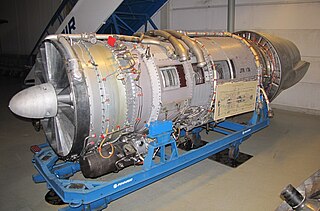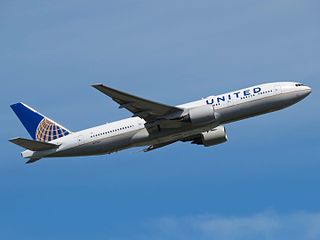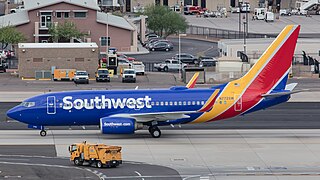
The Boeing 737 is a narrow-body aircraft produced by Boeing at its Renton factory in Washington. Developed to supplement the Boeing 727 on short and thin routes, the twinjet retained the 707 fuselage width and six abreast seating but with two underwing turbofans instead of four. Envisioned in 1964, the initial 737-100 made its first flight in April 1967 and entered service in February 1968 with Lufthansa. The lengthened 737-200 entered service in April 1968, and evolved through four generations, offering several variants for 85 to 215 passengers.

The Kegworth air disaster occurred when British Midland Airways Flight 092, a Boeing 737-400, crashed onto the motorway embankment between the M1 motorway and A453 road near Kegworth, Leicestershire, England, while attempting to make an emergency landing at East Midlands Airport on 8 January 1989.

The Pratt & Whitney JT8D is a low-bypass turbofan engine introduced by Pratt & Whitney in February 1963 with the inaugural flight of the Boeing 727. It was a modification of the Pratt & Whitney J52 turbojet engine which powered the US Navy A-6 Intruder and A-4 Skyhawk attack aircraft. Eight models comprise the JT8D standard engine family, covering the thrust range from 12,250 to 17,400 pounds-force, and power the 727, 737-100/200, and DC-9. The updated JT8D-200 family, covering the 18,900 to 21,000 pounds-force, powers the MD-80 and re-engined Super 27 aircraft. The JT8D was built under license in Sweden as the Volvo RM8, a redesigned afterburning derivative for the Saab 37 Viggen fighter. Pratt & Whitney also sells static versions for powerplant and ship propulsion as the FT8.

The Pratt & Whitney PW4000 is a family of dual-spool, axial-flow, high-bypass turbofan aircraft engines produced by Pratt & Whitney as the successor to the JT9D. It was first run in April 1984, was FAA certified in July 1986, and was introduced in June 1987. With thrust ranging from 50,000 to 99,040 lbf, it is used on many wide-body aircraft.

The CFM International CFM56 series is a Franco-American family of high-bypass turbofan aircraft engines made by CFM International (CFMI), with a thrust range of 18,500 to 34,000 lbf. CFMI is a 50–50 joint-owned company of Safran Aircraft Engines of France, and GE Aerospace (GE) of the United States. GE produces the high-pressure compressor, combustor, and high-pressure turbine, Safran manufactures the fan, gearbox, exhaust and the low-pressure turbine, and some components are made by Avio of Italy and Honeywell from the US. Both companies have their own final assembly line, GE in Evendale, Ohio, and Safran in Villaroche, France. The engine initially had extremely slow sales but has gone on to become the most used turbofan aircraft engine in the world.

Aloha Airlines Flight 243 was a scheduled Aloha Airlines flight between Hilo and Honolulu in Hawaii. On April 28, 1988, a Boeing 737-297 serving the flight suffered extensive damage after an explosive decompression in flight, caused by part of the fuselage breaking due to poor maintenance and metal fatigue. The plane was able to land safely at Kahului Airport on Maui. The one fatality, flight attendant Clarabelle "C.B." Lansing, was ejected from the airplane. Another 65 passengers and crew were injured. The substantial damage inflicted by the decompression, the loss of one cabin crew member, and the safe landing of the aircraft established the incident as a significant event in the history of aviation, with far-reaching effects on aviation safety policies and procedures.

TACA Flight 110 was a scheduled international airline flight operated by TACA International Airlines, traveling from San Salvador to New Orleans, with a stopover in Belize City. On May 24, 1988, the flight encountered severe thunderstorm activity on its final approach to New Orleans International Airport. As a result, the brand new Boeing 737-300 suffered flameout in both engines while descending through a severe thunderstorm, but the pilots made a successful emergency landing on a grass levee adjacent to NASA's Michoud Assembly Facility, with no one aboard sustaining more than a few minor injuries, and with only minor hail damage to the intact aircraft. Following an on-site engine replacement, the jetliner took off from Saturn Boulevard, a road which had previously been an aircraft runway at Michoud. The aircraft was subsequently repaired and returned to service until it finally retired in 2016.

Southwest Airlines Flight 1248 was a scheduled passenger flight from Baltimore, Maryland, to Chicago, Illinois, continuing on to Salt Lake City, Utah, and then to Las Vegas, Nevada. On December 8, 2005, the airplane slid off a runway at Chicago-Midway while landing in a snowstorm and crashed into automobile traffic, killing a six-year-old boy.

Southwest Airlines Flight 1455 was a scheduled passenger flight from McCarran International Airport, Las Vegas, Nevada, to Burbank-Glendale-Pasadena Airport, Burbank, California, that overran the runway during landing on March 5, 2000. The aircraft, a Boeing 737-3T5, registration N668SW, came to rest on a city street adjacent to a gas station. The National Transportation Safety Board found that the incident was due to the pilots attempting to land with excessive speed. They also found that the air traffic controller placed them in a position from which their only option was a go around. Two of the passengers were seriously injured, and there were many minor injuries. As a result of the incident, the airport installed an Engineered Materials Arrestor System at the east end of the incident runway. The aircraft was written off, making the incident the 10th hull loss of a Boeing 737-300. This was the first major accident in the airline's 29-year history.

The Boeing 737 Next Generation, commonly abbreviated as 737NG, or 737 Next Gen, is a twin-engine narrow-body aircraft produced by Boeing Commercial Airplanes. Launched in 1993 as the third generation derivative of the Boeing 737, it has been produced since 1997.

The CFM International LEAP is a high-bypass turbofan engine produced by CFM International, a 50–50 joint venture between American GE Aerospace and French Safran Aircraft Engines. It is the successor of the CFM56 and competes with the Pratt & Whitney PW1000G to power narrow-body aircraft.

Southwest Airlines Flight 2294 (WN2294/SWA2294) was a scheduled US passenger aircraft flight which suffered a rapid depressurization of the passenger cabin on July 13, 2009. The aircraft made an emergency landing at Yeager Airport in Charleston, West Virginia, with no fatalities or major injuries to passengers and crew. An NTSB investigation found that the incident was caused by a failure in the fuselage skin due to metal fatigue.

Southwest Airlines Flight 812 was a Boeing 737-300 passenger jet that on April 1, 2011, suffered rapid depressurization while cruising at 34,000 ft (10,000 m) near Yuma, Arizona, leading to an emergency landing at Yuma International Airport. Two of the 123 people on board suffered minor injuries. The aircraft was operating Southwest Airlines' domestic scheduled service from Phoenix, Arizona, to Sacramento, California.

Southwest Airlines Flight 345 was a scheduled flight from Nashville International Airport, Tennessee, to New York City's LaGuardia Airport. On July 22, 2013, the Boeing 737 operating the route suffered a front landing gear collapse while landing at LaGuardia Airport, injuring 9 people on board. The aircraft, which was worth an estimated $15.5 million at the time, was written off and scrapped as a result of the accident.

Delta Air Lines Flight 1288 was a regularly scheduled flight from Pensacola, Florida to Atlanta, Georgia. On July 6, 1996, the aircraft serving the flight, a McDonnell Douglas MD-88, was on takeoff roll from Runway 17 at Pensacola when it experienced an uncontained, catastrophic turbine engine failure that caused debris from the front compressor hub of the left engine to penetrate the left aft fuselage. The cause of the engine failure was found to have been a fault in the manufacture of the fan. The failure of the airline to spot the resulting crack in the blade was a contributing factor.

British Airways Flight 2276 was a scheduled international passenger service from Las Vegas to London. On 8 September 2015, the Boeing 777-200ER operating the flight suffered an uncontained engine failure and fire in the left (#1) GE90 engine during take-off from Las Vegas-McCarran International Airport, prompting an aborted take-off and the evacuation of all passengers and crew. All 170 people on board survived, but 20 were injured.

On February 13, 2018, around noon local time, a Boeing 777-222 airplane, operating as United Airlines Flight 1175 (UA1175), experienced an in-flight separation of a fan blade in the No. 2 (right) engine while over the Pacific Ocean en route from San Francisco International Airport (SFO) to the Daniel K. Inouye International Airport (HNL), Honolulu, Hawaii. During level cruise flight shortly before beginning a descent from flight level 360, and about 120 miles from HNL, the flight crew heard a loud bang, followed by a violent shaking of the airplane, followed by warnings of a compressor stall. The flight crew shut down the failed engine, declared an emergency, and began a drift-down descent, proceeding direct to HNL where they made a single-engine landing without further incident at 12:37 local time. There were no reported injuries to the 374 passengers and crew on board and the airplane damage was classified as minor under National Transportation Safety Board (NTSB) criteria.

Southwest Airlines Flight 1380 was a Boeing 737-700 that experienced a contained engine failure in the left CFM International CFM56 engine after departing from New York–LaGuardia Airport en route to Dallas Love Field on April 17, 2018. The engine cowl was broken in the failure, and cowl fragments damaged the fuselage, shattering a cabin window and causing explosive depressurization of the aircraft. Other fragments caused damage to the wing. The crew carried out an emergency descent and diverted to Philadelphia International Airport. One passenger was partially ejected from the aircraft and sustained fatal injuries, while eight other passengers sustained minor injuries. The aircraft was substantially damaged.

On February 20, 2021, United Airlines Flight 328 (UA328/UAL328), a scheduled U.S. domestic passenger flight from Denver to Honolulu, suffered what was technically ruled a contained engine failure despite shedding large pieces of debris, approximately four minutes after takeoff from Denver International Airport (DEN). Parts departing from the engine cowling of the Boeing 777-222 aircraft resulted in a debris field at least 1 mile (1.6 km) long over suburban residential areas of Broomfield, Colorado. Falling debris was recorded by eyewitnesses using smartphone cameras and a dash cam. Debris fell through the roof of a private home and significantly damaged a parked vehicle.



















